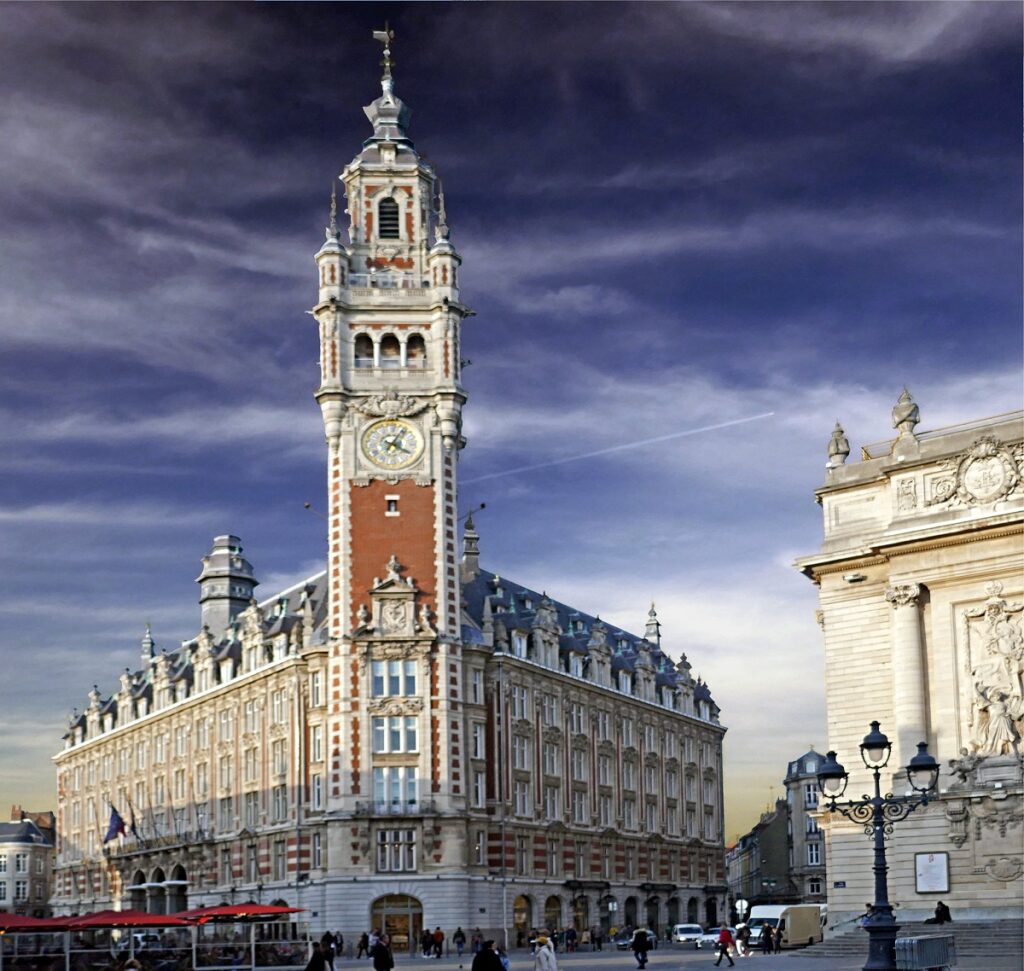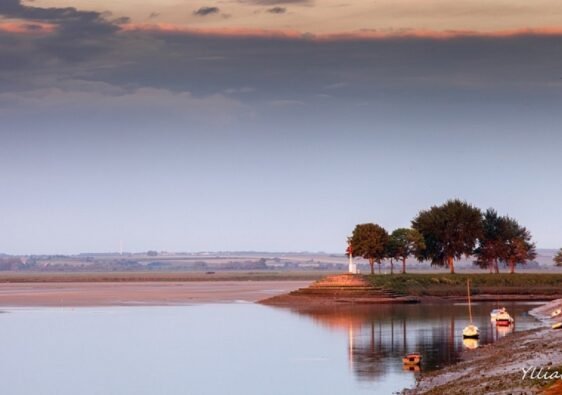Planning to visit Lille? You won’t be bored with this list of 13 must-dos in the capital of Hauts-de-France!
Lille enjoys a prime location, at the crossroads of major European cities such as Paris, Brussels, Amsterdam, and London. It is internationally known for its large braderie (flea market) organized every year in September. But this French city, close to the Belgian border, deserves a stop for many other reasons. Lille is known for its rich history and heritage, varied architecture, unique atmosphere, and unparalleled hospitality. And we confirm!
Are you planning a trip to the capital of Hauts-de-France? Here is our selection of the 13 essential things to do in Lille.
1. The belfry of the town hall

At 104 meters high, the belfry of Lille’s town hall is the tallest in the region. It is not only considered a symbol of freedom for all the municipalities of Hauts-de-France but also a landmark in the city. Built between the two world wars, the town hall combines traditional Flemish architecture with modern reinforced concrete. Its belfry, on which the two founders of Lille (Lydéric and Phinaert) are sculpted, is a UNESCO World Heritage site. From its top, you can enjoy a 360° view of the city and its surroundings: a great way to see the city from a different perspective. Listen closely, and you might hear its chimes!
2. La Grand’Place

No, it’s not a typo. La Grand’Place, without the “e”, is the name generally given to the central square of a city in northern France, Belgium, and the Netherlands. Its official name is Place du Général-de-Gaulle, in tribute to the famous Lille native. La Grand’Place in Lille is the heart of the city. This is where the massive Ferris wheel is set up during the Christmas period. The rest of the year, it is a meeting place, at the foot of the Goddess statue erected in 1842, and a thoroughfare for the people of Lille. Clearly, La Grand’Place is a vibrant and essential spot in Lille.
3. La Vieille Bourse of Lille

Let’s continue our tour of Lille’s must-sees right in the city center, at La Vieille Bourse. Located between La Grand’Place and Place du Théâtre, La Vieille Bourse is a set of Flemish Renaissance-style buildings. This monument was built at the request of wealthy merchants from the region in 1652. Its small inner courtyard, surrounded by 4 doors and 24 identical houses, now hosts chess players and booksellers. On summer evenings, tango classes are sometimes organized there. Don’t miss its colorful sculpted facades and its fascinating atmosphere if you plan to visit Lille!
4. The Palace of Fine Arts

If it rains during your stay, take this opportunity to visit Lille through the Palace of Fine Arts. You will find it on Place de la République, opposite the Prefecture du Nord. With its many prestigious paintings, it is considered one of the richest museums in France. As you walk through the aisles of this beautiful 19th-century palace, you can admire large collections of European works, especially Flemish and Dutch. Rubens, Goya, Delacroix, Courbet, as well as Rodin and Claudel, are some of the great artists displayed in the permanent collection. Be sure to check for temporary exhibitions during your visit!
🔗 Read Also: 16 Best things to do in Baie de Somme for first time visitors
5. Le Vieux Lille

Imagine charming cobbled streets lined with magnificent Flemish architecture and spread over nearly 2 km². You are in Le Vieux Lille! It is undoubtedly the city’s essential district. Its brick and stone facades testify to the city’s past, from the 14th to the 20th century. Le Vieux Lille is a district appreciated by both locals and visitors. It is full of art galleries, small shops and luxury stores, as well as popular cafes, bars, and restaurants. Whether you’re visiting Lille, shopping, or just strolling, we highly recommend a tour of Le Vieux Lille.
6. Wazemmes Market

Every Tuesday, Thursday, and Sunday morning, the Wazemmes market attracts crowds for its popular and colorful market. You will find everything from fruits and vegetables to textiles, as well as local and foreign products. The Wazemmes market is known for its friendliness and is a must-visit during a stay in Lille.
7. The Citadel of Lille

Wondering what to do in Lille? Head to the Citadel, hidden by the greenery of its park and the Bois de Boulogne. Built by Vauban on the orders of Louis XIV, the Citadel of Lille was nicknamed “the queen of citadels” in the 17th century. Star-shaped and surrounded by five bastions, it was built to protect Lille after its conquest. On sunny days, it is a favorite walking spot for the city’s residents.
8. Rehabilitated Places of Lille

Lille has always been an industrial land, especially in the coal, textile, and steel sectors. It is also a land of culture and was even designated European Capital of Culture in 2004. The city has evolved over time by giving a second artistic and/or cultural life to many industrial sites. Among these rehabilitated places, we can mention:
- La Piscine (Roubaix) : This former art deco swimming pool has been transformed into a museum, housing composite collections of applied and fine arts dating from the 19th century, including fabrics, decorative arts, sculptures, paintings, ceramics and drawings.
- Le Tripostal : This former mail sorting building has been transformed into a contemporary art exhibition hall and a performance hall.
- Gare Saint-Sauveur : This former freight station now houses a bar, a cinema, and an exhibition hall.
- Maisons Folie de Wazemmes and Moulins : These former textile mills have become cultural and exchange places aiming to highlight popular cultures.
9. Beers and Culinary Specialties

Beer enthusiasts will find their happiness in all the city’s breweries serving excellent local and Belgian beers. But why just taste it and not learn about brewing? After discovering beer theoretically following François’s explanations, move on to practice and crush the malt that will be used to make your beer! After this 4-hour training for a sum of 50€, brewing beer will no longer be a mystery to you.
Visiting Lille also means discovering rich culinary specialties inspired by Flemish gastronomy. On the menu of an estaminet, a typical restaurant of the region, you will find, among other things, potjevleesch or waterzoï, Flemish carbonnade, welsh (a dish of Welsh origin), Maroilles pie, or the essential mussels and fries during the big braderie. For dessert, try Fred’s Merveilleux, or perhaps you’d prefer the waffles from Maison Meert?
10. The Churches

Like all major French cities, Lille also has its share of remarkable churches. Two of them are particularly worth a look if you’re wondering what to do in Lille:
- Saint-Maurice Church: Built between the 14th and 20th centuries in a neo-Gothic style, this church is located a few meters from Lille-Flandres station. Its interior stained glass windows are impressive.
- Notre-Dame de la Treille Cathedral: This atypical church dedicated to the Virgin was only completed in 1999. Its very contemporary main facade contrasts with its 13th-century Gothic style.
11. Rue de Béthune

Want to shop during your discovery of Lille? Head to Rue de Béthune, where you will find all the major store chains. To refuel between two shops, just order a delicious Liège waffle at one of the many stands on the street. Rue de Béthune also has two cinemas, which can be a good alternative on rainy days. This street is pedestrianized every day and at all hours, making it particularly pleasant!
12. Hospice Comtesse

As its name suggests, the Hospice Comtesse is an old hospital dating from medieval times. Founded by Countess Jeanne de Flandre in her own palace in 1237, it welcomed patients until 1939. Located in the Vieux Lille district, the Hospice Comtesse now houses a museum and bears witness to a bygone era. You will discover a Flemish house from the 17th and 18th centuries, art collections in the former dormitory of the nuns, and the “sick room” dating from the 15th century where exhibitions are now regularly organized.
13. Charles de Gaulle’s Birthplace

Visiting Lille also means discovering a part of French history. Few know it, but General de Gaulle, a former statesman, was born in his maternal grandparents’ house in Lille in 1890. He spent many holidays there as a child and always had a special affection for his hometown. This 19th-century bourgeois house is now a museum open to the public. Passionate about history? Don’t hesitate to add it to your list of essential things to do in Lille!
How to get there ?
It is possible to reach Lille very easily from major French cities:
- Train: Lille has two stations, Lille-Europe and Lille-Flandres, both within walking distance of the city center.
🚆 Check Train Schedules & Prices
- Bus: The bus station is located along the Lille-Europe TGV station.
- Plane: The airport is located outside the city, in Lesquin. You will arrive in the center of Lille after about 20 minutes by shuttle, VTC, or taxi.
- Car: Lille is easily accessible by car. From Paris, for example, just take the A1 and arrive in Lille after 2h40 of driving.
Looking for a flight? Don’t hesitate to check out our partner’s website, the Skyscanner flight comparator!
How to get around?
On-site, you will find two metro lines, a tram, buses, and self-service bikes, the V’Lille. For those who would like to drive there, the city offers many underground car parks.
Also, because visiting Lille is not just about a monument, consider the City Pass for your stay. Valid for 24 or 48 hours, this pass allows you to discover the city while enjoying free entry to 30 tourist sites and attractions in Lille. The City Pass also offers free use of the city’s public transport.
Where to stay in Lille?
Are you convinced? All that’s left is to find the best place to sleep in Lille during your stay. The Vieux-Lille, lively day and night, offers a picturesque setting and hosts various city attractions. The lively Lille-Centre district is the choice for proximity. It allows quick access to stations, shops, bars, and many places of interest. To be closer to the two stations, you can also opt for the Euralille business district. Finally, if you are looking for peace and greenery, you will fall in love with the Bois Blancs residential area, crossed by the Deûle river and the canal.
Hotels or Airbnb, the choice is vast. To find your ideal accommodation at the best price, visit this hotel comparator website!
You now have the keys to visit Lille. What are your favorite must-sees?



